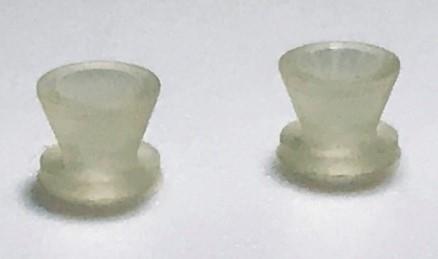
“The results of our recently completed 90-day DisappEAR animal study are exciting for two significant reasons,” said Lishan Aklog, M.D., PAVmed’s Chairman and Chief Executive Officer.
“First, the resorbable ear tubes, machined from blocks of a proprietary silk technology, performed very well from a functional and anatomic point of view, retaining their position and remaining patent for the duration of the study. Perhaps more impressively, the tubes demonstrated unexpected surfactant properties which appear to provide several unique benefits over traditional plastic tubes, including enhanced flow of fluid in and out of the tube and potential intrinsic antimicrobial properties.”
Christopher J. Hartnick, M.D., Professor of Otolaryngology at Harvard Medical School and Chief of Pediatric Otolaryngology at Massachusetts Eye and Ear Infirmary and Massachusetts General Hospital, performed the study. He implanted eighteen DisappEAR ear tubes, one in the tympanic membrane (ear drum) of each ear of nine chinchillas and evaluated them endoscopically at regular intervals over three months.
Ear drops delivered under direct vision demonstrated rapid wicking through the tube channel in contrast to plastic tubes where surface tension causes the drop of fluid to sit on the tube orifice and not pass through the channel. At the completion of the study, the ear tubes were explanted and found to be patent without structural degradation and the tympanic membranes showed good healing.
The unexpected finding was that there were no cases of otorrhea – a difficult to manage condition where pus and fluid drains out of the middle ear and into the ear canal. When traditional plastic ear tubes are used in clinical practice, as well as in this animal model, otorrhea typically occurs in at least 25-30% of recipients, despite administration of antibiotic ear drops.
“The surprising absence of otorrhea in this study suggests that these silk ear tubes may possess unique and unexpected surface properties which enhance drainage of fluid from the middle ear compared to plastic ear tubes,” said Dr. Hartnick. “If these results are reflected in longer term follow-up and in human cases, this would represent a major breakthrough in the treatment of millions of children with chronic ear infections and fluid buildup.”
PAVmed licensed the technology underlying its DisappEAR resorbable ear tube from a group of leading academic institutions, including Tufts University and two Harvard Medical School teaching hospitals – Massachusetts Eye and Ear Infirmary and Massachusetts General Hospital.
The tubes are manufactured from a proprietary aqueous silk technology which is designed to slowly be reabsorbed over the intended course of treatment.
Each year, up to one million children with persistent ear infections (otitis media) or middle ear fluid collections (effusions) undergo placement of metal, plastic or latex bilateral ear tubes to ventilate and drain the middle ear.
This procedure, formally known as bilateral tympanostomy, is the most common pediatric surgical procedure in the United States. Up to 50% of patients require repeat surgery under general anesthesia to remove the tubes once they are no longer needed or if they become dislodged and do not fall out of the ear canal on their own.
PAVmed believes that DisappEAR has the potential to revolutionize the care of children with complex or recurrent otitis media by eliminating the need for a second procedure as well as the seven to 10-day post-operative ear drop regimen, which is challenging for parents to administer. It also expects fewer complications, including ear tubes remaining in the ear canals for years after becoming dislodged and causing pain, bleeding or obstructing a clear view of the ear drum to identify occult middle ear infection.
Based on premium pricing and cost savings from replacing post-procedure antibiotic drops, we estimate an annual domestic market opportunity for this device of $200-$300 million.
Source: Company Press Release



